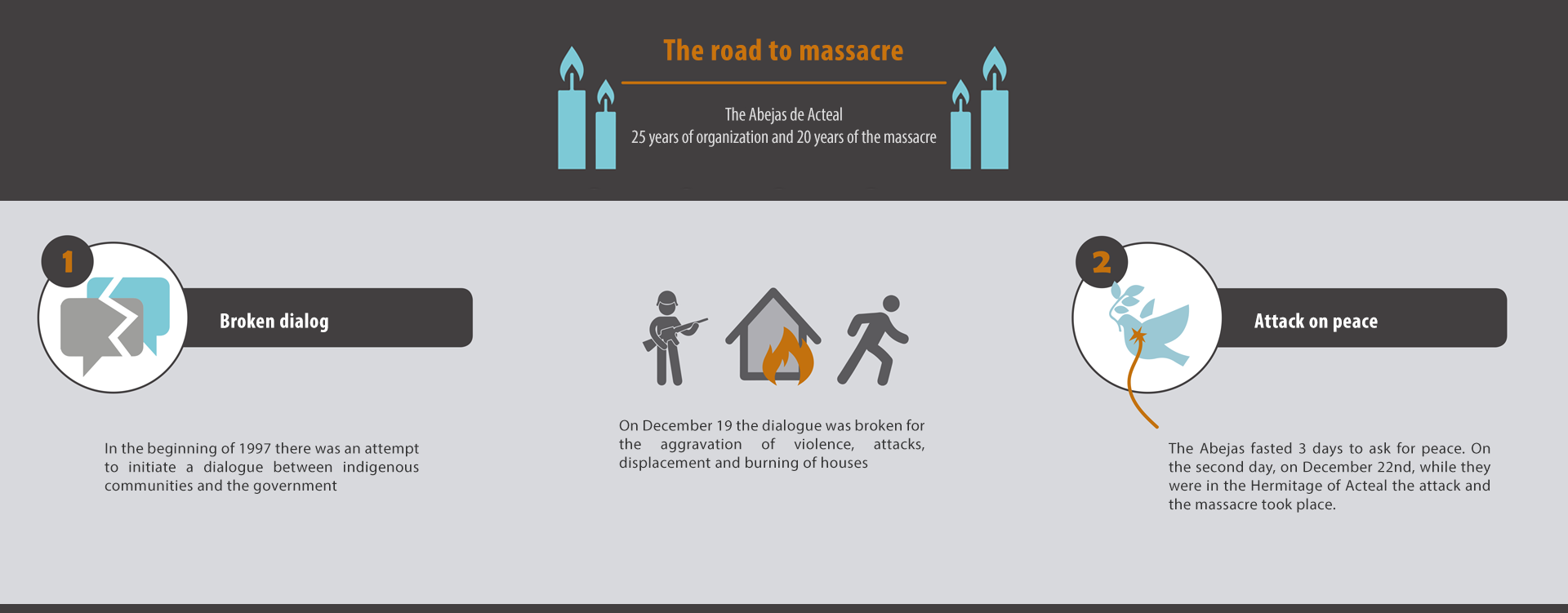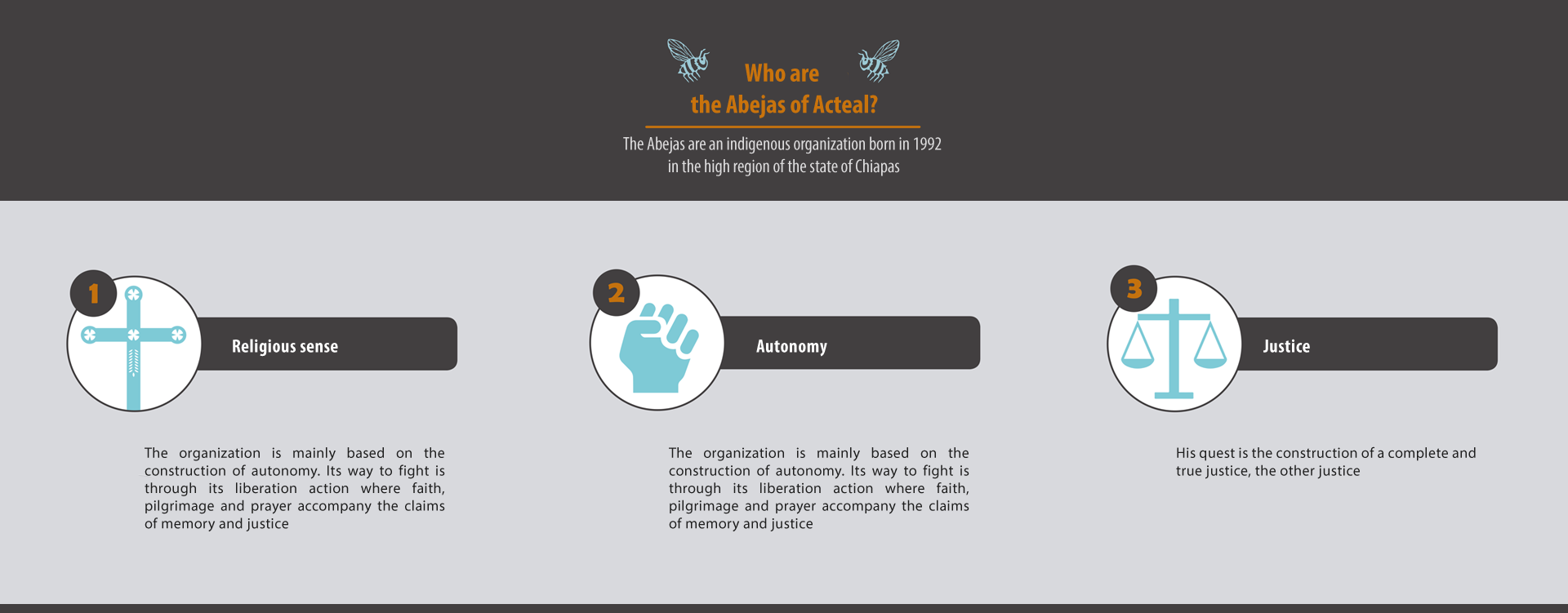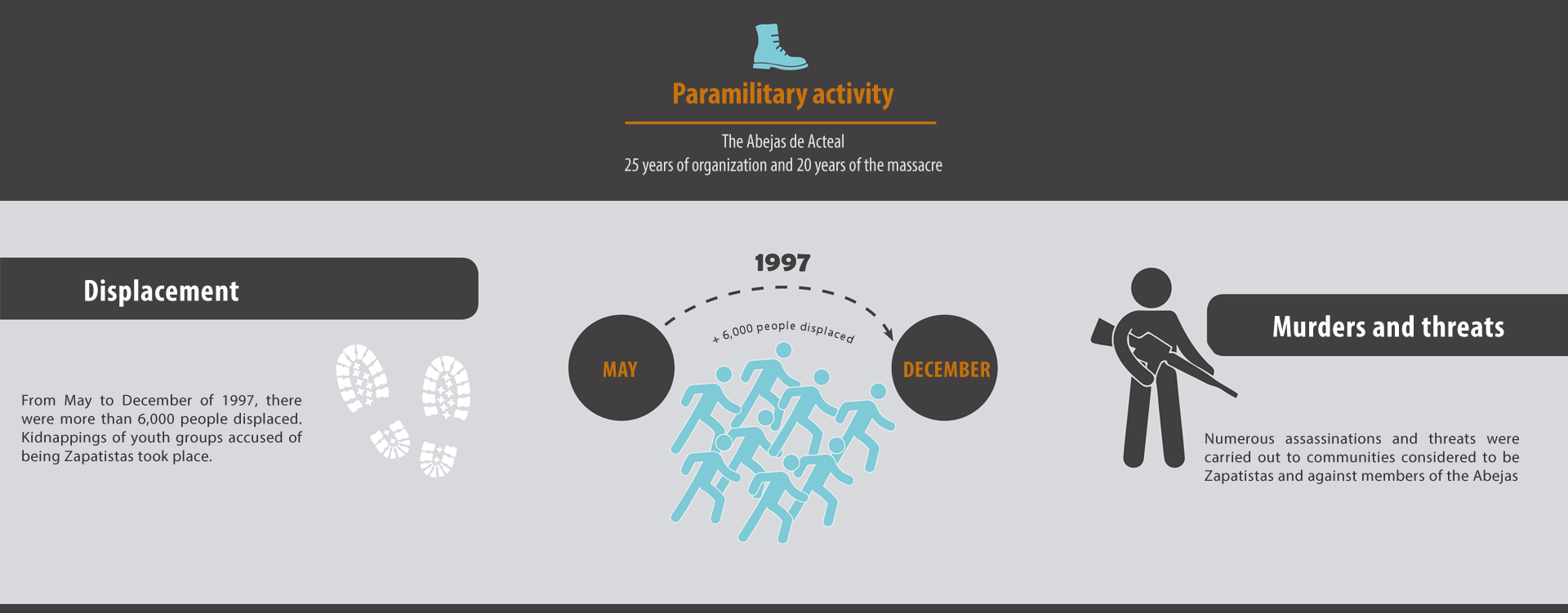Filed under: Analysis, Indigenous, Mexico, Repression, Southern Mexico

Editor’s note: IGD encourages readers to visit the original microsite.
The memory of the Peoples is a crack in obscurity and forgetting. Memory carries with it the dignity to confront the impunity of governments. It strengthens the struggles and resistances that point toward freedom for those who inherited the glow of rebellion. Memory also motivates the construction of social change toward a world different from this system of exclusion and death.
Processes of resistance centering on Memory, Truth, and Justice, such as those of the Civil Society Organization of the Bees of Acteal (Las Abejas) build autonomy through deep struggle. They have suffered through counterinsurgency strategies implemented by the government since the creation and execution of the “Chiapas ‘94” Campaign Plan, a strategy developed by the Mexican Army to annihilate the uprising of the Zapatista Army of National Liberation (EZLN). Facing down this aggressive action, the peoples’ demand for justice has pushed forward a constant struggle for the rights to truth and peace.

Aggressions linked to this counterinsurgency strategy began in 1994 with 12 days of direct confrontation between the Mexican Army and EZLN. They continued in a second period, from 1995 to 1999, characterized by the creation and implementation of paramilitary groups in the Northern, Jungle and Highland regions, with the support of federal, state, and municipal governments. The civilian population suffered through displacement, extrajudicial executions, forced disappearances, torture, rape, physical assaults, and harassment, among other crimes against humanity.
The third period, from 1999 until the present moment, is characterized by a continuous comprehensive war of attrition, disguised by the federal and state authorities’ rhetoric of “respect” for the population, while simultaneously creating openings for confrontations in communities through social programs. These programs become counter-insurgency strategies the moment community leaders are coopted, and become instruments of the organizations that they are part of, with their work reduced to that of agents of the government, with the partisan interests, political favors, and political control of territory that comes with it.
The fourth period, which coexists with the previous one, we find in the Fourth Generation War, or the Fourth World War as it is called by the Zapatistas, experienced as a deep, psychosocial offensive used by all State media to hide and distort the real problems of the country. They seek to destroy the resistance of the peoples, submitting them to the will and interests of a few groups who hold political and economic power through the implementation of a military police state.
This counter-insurgency strategy defines the continuity that we emphasize in this memory through multimedia elements based on the oral tradition of men and women who have forged the road, with struggle and pain, amid this war against the people. Through some of the forced displacements that have been suffered by Las Abejas between 1996 and 2016, we can see how paramilitary actors who committed crimes against humanity continue operating under the shroud of impunity, regrouping and giving rise to forced disappearances, systematic harassment, and conflicts within communities in a new context of generalized violence.

II. A Window Into Memory: Forced Displacement and Violence in Los Altos, Chiapas
Violence in the context of counterinsurgency has been documented in the region of Los Altos, Chiapas since February 1994 by the Fray Bartolomé de las Casas Center for Human Rights (Frayba). The result of this violence has been a humanitarian crisis of forced displacement.
Between May and December 1997, over 6,000 people were displaced in this region. In the municipality of Chenalhó alone, more than 10,000 people were registered in December 1998 as being forcibly displaced as a consequence of the violence following the Acteal massacre. These people came from the communities of Puebla, Yaxgemel, Chuchtic, Miguel Utrilla Los Chorros, Tzanembolóm, C’anolal, Centro Quextic, Tzajalhucum, Poblado Quextic, Acteal Alto, Yibeljoj, and Aurora Chica. Prior to the massacre, the camp of Los Naranjos (now Acteal) had 325 displaced people, who had come from the communities of Quextic and Tzalucum. Following the massacre, the whole population had to leave.
These violent actions included the secret organizing of “sectors of the civilian population operating under orders in support of Army operations” who received training and support from state forces as set out in the “Chiapas 94” Campaign Plan that was developed by the National Defense Secretary (SEDENA).
The clearest case of impunity that exists around this counterinsurgency scenario is the Acteal Massacre. Despite being directly identified by survivors of the massacre, the material authors of the massacre were freed. In 2013, they returned to their communities and began harassing various non-governmental organizations.

The communities of Los Chorros and the Puebla ejido were the ones where the conflicts that led to the Acteal Massacre began. Los Chorros was the main center for paramilitary training and activity, where most of the people identified as perpetrators of the massacre were based.
Currently, in the Miguel Utrilla Los Chorros ejido, an alliance of powers is using access to basic services – water and electricity – as a pressure tactic and a means of political repression against members of Las Abejas in the Río Jordán neighborhood. On November 30, 2015, they were deprived of water and electricity, and also faced threats to their safety due to assaults by community authorities.
The group currently provoking harassment against the families of Las Abejas in this ejido is made up of an alliance of former Las Abejas members who have become political party supporters and individuals who joined the paramilitaries in 1997. At the time they were members and leaders of the PRI political party and now are members of the Green Ecological Party of Mexico (PVEM), which currently governs in the municipality of Chenalhó and Chiapas.
In the specific case of the ejido of Puebla, their recent history demonstrates certain patterns of military counterinsurgency tactics that have provoked recurring forced displacements, in 1997, 2013, and 2016.

In 1997, the families of Las Abejas were displaced when these strategies were first brought to Los Altos in Chiapas. The testimony of one person, who was 10 at the time, recalls how they fled from direct violence, together with hundreds of people from the ejido of Puebla and the communities of Yibeljoj, Yaxjemel, Los Chorros, Sanembolom, Kanolal, Tzajalukum, and Quextic.
Through their memory, they recount how 1,095 people took refuge in the camp at San Juan Diego X’oyep. This camp was created by Las Abejas, with support from organizations and parishes in the region, because of the violence committed by armed groups against the communities who had declared their territories as neutral zones. At the same time, camps were built in Acteal, Tzajalch’en, and San Cristóbal de Las Casas.
In Chenalhó, documentation carried out by Frayba indicates that some members of these armed groups were incarcerated after the massacre and gradually released between 2012 and 2013. Immediately afterward, the harassment resumed and a political conflict was created that resulted in a second forced displacement of Las Abejas from the ejido of Puebla, this time disguised as a religious issue.
In 2013, Agustín Cruz – identified as one of the leaders of paramilitary groups active in Los Altos, Chiapas – decided to take over a piece of land where members of Las Abejas had built a church.
Despite strong and repeated condemnations, the authorities turned a blind eye as this person and his group invaded the land, surrounded it with barbed wire, destroyed houses, and stole construction material. The aggressions intensified: arbitrary detentions, cruel, inhumane and degrading treatment, property destruction, thefts, and houses burned, until 17 families found themselves forcibly displaced.
Agustín Cruz Gómez is the same person who, in 1997 as a Presbyterian pastor and commissioner of the Puebla ejido, led the attack against Las Abejas and others who decided not to affiliate themselves with the PRI. Faced with violence, the pacifist organization and families in that community were forcibly displaced for refusing to give money for the purchase of arms and ammunition. He is the same person who blessed the weapons of the paramilitary groups that perpetrated the Acteal massacre.
The actions that occurred in the Puebla ejido at the end of April 2013 coincided with the release of Jacinto Arias, a paramilitary leader, former mayor of Chenalhó, and native of the Puebla ejido, as well as the release of other persons who had been identified as participating in the paramilitary groups from the communities of the Miguel Utrilla Los Chorros ejido, Acteal Alto, Yibeljoj, Pechiquil, La Esperanza, and C’anolal. That is to say, due to the release of paramilitaries by the National Supreme Court of Justice (SCJN), attacks resumed against Las Abejas’ autonomous and peaceful project and violence spread throughout the region.

In 2016, an armed dispute emerged between party members, now divided between the PRI and the PVEM, over political power in Chenalhó, which caused widespread violence in the ejido of Puebla. Out of fear, 81 members of Las Abejas (which avoids party conflicts), took refuge in Acteal, marking the third forced displacement of this same community.
This violence is rooted in the 2015 electoral process in Chiapas, which generated a series of conflicts in several communities and municipalities and continues to this day. Confrontations have been led, above all, by sympathizers of the PRI and PVEM, leading to vacancies in various municipal mayors’ offices. Both groups are armed and act with the complicity of the Chiapas government.
From 1997 to 2016, through the memory of Las Abejas and the archive maintained by Frayba, it is clear that there is a consistency to the counterinsurgency strategies aimed at destroying the community fabric and causing harm to the organized peoples of Chiapas who promote peaceful actions, such as Las Abejas.
These strategies have been concealed over time, perpetuating impunity by protecting those who have committed crimes against humanity: in 1997 as paramilitaries, in 2013 by creating supposedly religious conflicts, and in 2016 through widespread violence caused by armed groups attached to political parties.

III. Community Division as Counterinsurgency Strategy
On their path, Las Abejas has gone through two splits, one in 2008 when a group left the organization to form Las Abejas Chiapas, and another in 2014,with the creation of the Consejo Pacifista Sembradores de Paz (Sowers of Peace Pacifist Council).
The first break was encouraged under the government of Pablo Salazar Mendiguchía, which was characterized by a re-adjustment of the state’s counter-insurgency strategies, with one of the most palpable effects of this adjustment being the offering of social programs that sought to bribe the most visible or worn-out members of a group, in this way sowing discord and divisions in communities that were continuing to struggle for justice.
In 2014, a group of survivors of the Acteal massacre, along with other members of Las Abejas, decided to leave the organization and create the Sowers of Peace Pacifist Council. After the split, they used threats as well as physical and legal harassment against members of Las Abejas and the organization’s board of directors, looking for a way to gain power and control over the organization, “to deprive us of the organization’s physical and symbolic spaces in Acteal – spaces that are a place for memory.” They acted according to the logic of a total war of attrition.

IV. The Release of Paramilitaries, Another Example of Impunity
“The paramilitaries came from every community, they are our brothers, our neighbors, but they were trained by the military. That was the strategy of President Ernesto Zedillo, the governor of Chiapas, Julio César Ruíz Ferro, and the mayor Jacinto Arias Cruz – they were all in agreement with this strategy to get rid of the social organizations.”
(Female member of Las Abejas, displaced in 1997)
Since August 12, 2009, 87 individuals sentenced for their roles in the Acteal Massacre have been set free, one by one. These individuals were identified by the survivors of the massacre as having taken part in the extrajudicial execution of 45 individuals, as well as four unborn children. After having set them free, the government of Chiapas set up monthly economic support for them, purchased land, and built housing for them in the municipalities of Acala and Villaflores.
This group presents itself as victims, “unjustly” accused for participation in the massacre. They are supported by their families, who have protested for their freedom, and supported by the Presbyterian Church of Mexico, as well as the Centro de Investigación y Docencia Económicas (Center for Economic Research and Teaching, CIDE). The mass media such as Televisa and TV Azteca, along with federal and state authorities and the Supreme Court played important roles during the public actions calling for their release.

The release of the material authors of the Acteal Massacre took place despite the fact that during the legal proceedings, the survivors of the massacre recognized the detained individuals as the perpetrators, and the fact that some of the accused admitted their guilt. The judicial investigation was never effective at any point, and the legal process was deliberately weighed down with violations of due process as a means to add fuel to impunity, since the courts themselves did not effectively carry out the proceedings.
Despite this, the communities of Las Abejas have persevered with long-term resistance actions in search of Memory, Truth, and Justice, allowing the case to be admitted to the Inter-American Commission on Human Rights, and requested that the Permanent Tribunal of the Peoples (TPP) condemn the Mexican government for the Acteal Massacre.
Alongside these actions, the communities have gone on building an Other Justice, through their commemorations, symbolic acts, gatherings against injustice, and the detailed identification of the material and intellectual authors of these crimes which are still under the veil of impunity.
A culture of deep consideration of the local has been born through these expressions and exchanges, shining brightly toward a universal identity in which we can all see ourselves reflected. In these spaces, new forms of denunciation occur, in the construction of alternative justice and expressed through art: theatrical representations, drawings, visual arts, photography, video, music, and poetry.
Examples of these actions are the work of communication, handicrafts, and theater and choral performance; the expression and voice of the rebel dignity of the youths of Las Abejas. These are ways to transmit their thinking, their sensibility and their interpretation of history. At the same time, they are ways of manifesting the hope that has been inherited from the ancestors, as a means of transcendence through living memory and for liberation.
Historical memory for Truth and Justice is a light and a breeze that refreshes us along the long road. In the social and community context, it is a means of recognition for the historical continuity of a people, beginning with the traditions that capture values and wisdom accumulated throughout the centuries. These traditions are renewed, generation by generation, and express themselves in exchanges with other peoples and in new tools for struggle.
Faced with crimes against humanity such as the Acteal Massacre, alternatives are emerging where the Memory that rebels and recognizes itself as it traverses the paths of time, is the impulse for new forms of struggle based on autonomy but above all in the present moment, where it manifests itself through the practice of a dignified life of Lekil Chapanel (True Justice in Tsotsil Maya).




